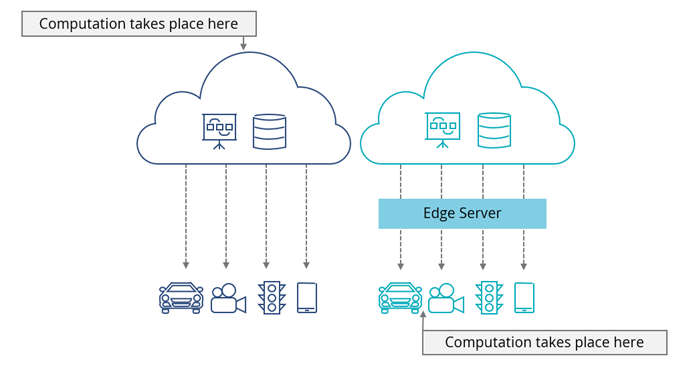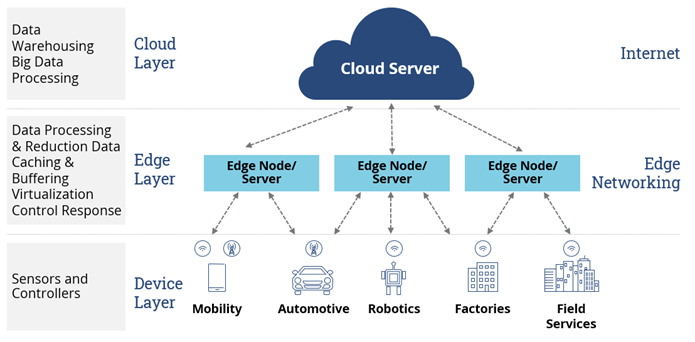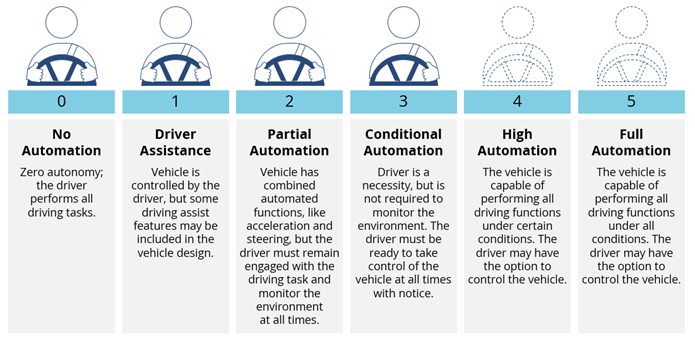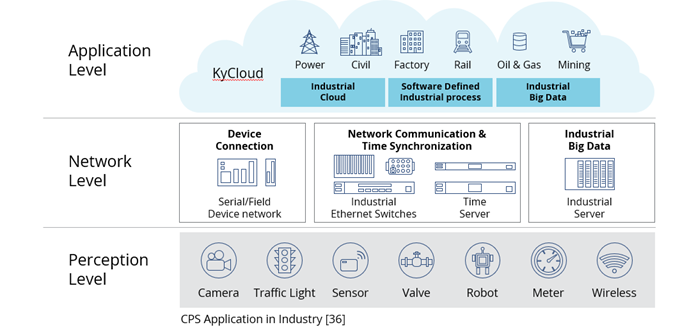More than 80% of enterprises in the automotive industry say they have a cloud architecture strategy or have been through a cloud implementation. And, while cloud promises to solve enterprise challenges with scale and flexibility, it is not the answer to all technology challenges. This is especially true in the automotive digital ecosystem.
In the ISG 2023 Smart Manufacturing Survey, only 26% of automotive companies had adopted edge computing and more than 50% were just adopting it or had not yet evaluated it. The data required to deliver connected vehicle driving and passenger services will reach and potentially surpass yottabytes. This is far greater than current enterprise infrastructure can handle. Yet the smart and autonomous vehicle depends on the promise of such computational power to be able to make the right safety and commuting decisions. Rather than using data that is sent across the cloud and internet, connected vehicles need immediate responsiveness to ensure safety, comfort and security for passengers, drivers and surrounding environments.
This means they will need a robust, well-connected and use-case-led architecture to define the purpose, management and cost of the data loads. Most organizations are at a crossroads with these issues. One solution includes a model that allows for both a distributed and symbiotic architecture that enables a comprehensive approach, with edge computing in mind.
Edge and Cloud Technologies Do Not Compete; They Are Symbiotic
While enterprise data is generated at the edge by Internet of Things (IoT) sensors and other technologies in greater and greater volumes, it relies on the cloud for comprehensive storage, processing and management. But the cloud is not efficient enough to handle the growing volume of data generated at the edge. This is where edge computing comes into play.
Edge computing pushes the computational infrastructure closer to the data source where it is needed, to address issues such as response time, data security and power consumption. Like cloud computing, edge computing allows compute, storage and applications to be consumed by end users, but edge computing has much greater geographical distribution and proximity to end users.

Figure 1: Cloud Computing vs. Edge Computing
Source: https://www.spiceworks.com/tech/cloud/articles/edge-vs-cloud-computing/
Edge computing is not a technology itself; it is an architectural approach to improve the performance of the overall environment. In a simple edge computing architecture, shifting computing power and storage to locations closer to the source of data can have an immense impact. Here is a simple graphic demonstrating an edge computing architecture and how it interfaces with the cloud layer to leverage foundational resources to process data closer to users and data sources.

Figure 2: Simple Edge Computing Architecture
Source: https://www.wipro.com/infrastructure/edge-computing-understanding-the-user-experience/
Cloud computing complements an edge strategy by bringing tremendous synergies, including performance, scalability and flexibility to run modern IT architectures in an optimized and cost-effective manner.
Please fill out this form to continue.
The Promise of the Connected Vehicle
Edge in the Automotive Industry Is Not New
Where computation takes place is the key differentiator and one of the crucial foundations for developing smart and connected products. An architecture that supports a distributed computational load will provide the necessary scale to manufacture and attach services to physical assets, particularly for the connected vehicle. The full potential of the connected vehicle is yet to come to fruition.
Successful proofs of concept have existed even before the cloud. In 1961, a team at Stanford University created a non-passenger vehicle designed to drive autonomously on the moon. Even earlier, the first recorded driverless car, the Houdina, made its debut in New York in 1925, almost 100 years ago. The Houdina used radio antennae as the only available endpoint for “edge” technology. Today, vehicles have many more devices onboard. The autonomous and connected vehicles of the future will require computational power in small components and lower-cost technology.
The manufacturing industry has evolved the vehicle over time to increase the degree to which its operation can be automated. As the vehicle performs more and more of the driving functions, its reliance on edge computing grows.

Figure 3: Automation Levels
Source: Society of Automotive Engineers
The full potential of edge needs to be harnessed for the connected vehicle to provide safe and responsive services for passengers and drivers. Today, the industry is working through two significant challenges:
- Trust in connected vehicles
In 2018, the Automotive Edge Computing Consortium (AECC) was formed by automotive, telecommunications and technology companies to develop use cases and reference architectures for smart and connected vehicles. From their studies, they forecasted 100 million connected vehicles between 2025 and 2030 with data volumes of 100 petabytes per month at a very conservative estimate of 1 GB per month per car.
In 2016, an estimated 5% of cars had driver assistance on board. In a span of less than twenty years, at least 60% of vehicles sold will include Level 2 “partial automation” as described in Figure 4. Today, driver assistance is considered a basic feature.
Edge capability addresses the autonomous driving challenges of the past. Rather than the enormous volume of data being crunched at a central location in the cloud, the processing and decision-making happens remotely. And not just remotely but connected to other vehicles (V2V) and other smart devices. Still, we are not completely comfortable with Level 5 autonomous driving and decisions being made at the edge. An academic paper on the ethics of AI for driving poses the provocative question: How many crashes are we willing to tolerate from self-driving cars, per million kilometers? - The technology that allows for perception of the physical environment
Leveraging devices on the periphery certainly reduces latency and the cost of processing and transferring data. But, most importantly, it provides a vehicle the capability for perception.
The human brain is capable of perception through its network of hundreds of billions of neurons. The behavior of a single neural circuit cannot explain or perform complex behaviors; it must be interconnected with other neural circuits. But outside the human brain, we have not solved the challenge of processing thousands of connections in one central place. We have tried this with our smart products through the cloud.
The brain makes quick decisions by leveraging learned models and conditions and then continuously updates these models from new input in the real world. We need technology to form perceptions and assign confidence to decisions so we can build trust in connected vehicles.
What Can Symbiosis of Edge and Cloud Achieve for the Automotive Industry?
The presence of various sensors can create a kind of perception that ensures connected vehicles to make fewer harmful mistakes and drive even more safely than the average human driver. While storing learned models for smart products in the cloud may make sense, the edge provides an advantage for perception and localized decisions.
The combination of IoT and onboard sensors on a connected vehicle, such as cameras, lidar, microphones and infrared, allow a vehicle to understand its surroundings. Akin to our human senses of smell, touch, hearing, sight and taste, these onboard sensors process key inputs for perception. When data from the edge is fused with localized algorithms, results can take the shape of vehicle-to-everything (V2X) communication, which uses wireless technology to connect vehicles with their drivers, passengers and surroundings.
Benefits of Connected Driver and Passenger Services
On-board capabilities can now be enriched with situational awareness capabilities and connected services that bring additional benefits. These include:
- Increased efficiency: We all have to juggle a personal and professional life, running late for an in-person or virtual meeting is common. Often, when in transit, people are multi-tasking with stops along the way for school drop-off, doctors’ appointments or even between work assignments. In a connected vehicle, not only is the fastest route to your destination recommended, but also a less carbon-intensive route, or even facilitating a more convenient location for an in-person meeting. Being connected to other vehicles, transport networks, smart cities and enterprise infrastructure allows end users to have tailored and stress-free experiences.
- Increased safety and ease: Onboard systems can already differentiate between colors of traffic lights, signs and temporary road signals. With edge computing, outages to the grid powering digital signs or inadvertent coverage of signs due to graffiti or vandalism will not result in confusion or congestion. Rather, vehicles can be quietly re-routed, GPS updated or confirmed with correct coordinates to manage traffic flow without causing stress to passengers or drivers.
- Hazard prevention:By combining hazard detection and navigation with historic and current road conditions, connected vehicles can help passengers and drivers take precautions in heavy rainfall and flooding. Vehicles can be re-directed automatically with alternate routes that do not significantly increase time to destination.
- Customized response per location: Whether traveling across the country or even across state lines, the local rules and behaviors of pedestrians and drivers vary. Maintaining safety is contextualized with localized edge algorithms. Unexpected edge cases in one region can often be applied to another, i.e., steering safely around animals or jay-walking pedestrians or even adjusting to regional driver behavior like turning without signaling.
Edge Enables Modularization, Allowing Software Defined into the Physical Sphere
Edge computing enables an architecture that can handle onboard mechanisms. Similar to the networks that serve different purposes in the brain, edge computing provides a means of modularization to handle localized problems. Level 5 autonomous driving is not about the scenarios we do know and can simulate. Rather it prepares a vehicle for the ones we can’t know about or predict. It requires a system that incorporates decision-making ability capable of dealing with this unknown.
In their 2021 IEEE paper, Toward the Unified Principles for Level 5 Autonomous Vehicles, Wang, Huang, Li & Li proposed a new model for the connected and autonomous vehicle. This model leverages a more organic system approach (image below).

Figure 4: Edge Computing Model Enables Omni-Directional Integration
Source: https://www.sciencedirect.com/science/article/pii/S2095809920304008#f0035
The proposition is that, when connected properly, edge computing enables omni-directional integration and communication between components as in an organic system.
This goes beyond just the software and application requests and deals with the connected vehicles themselves and their interactions with other services. Examples include connection with emergency services and enabling detours for traffic around an accident. These capabilities demand a new reference architecture for edge computing, particularly in the smart product and asset-heavy industries. The edge reference architecture not only has the data network and application/service layer; it also has the perception level.
Edge Enables a New Distributed Architecture for Connected and V2X Vehicles

Figure 5: Cloud Control System Architectures, Technologies and Applications on Intelligent and Connected Vehicles
Source: https://cjme.springeropen.com/articles/10.1186/s10033-021-00638-4
The perception layer provides greater confidence about the unknown and it provides greater resiliency. Should one sensor fail, the ability to leverage others can be used to enable driving services. The potential to leverage sensors in the environment and connect in real-time to an ecosystem such as a smart city or smart supply chain is critical for safety and the comfort of the passenger.
Other benefits result from data being isolated at the edge. Because data has limited exposure at the edge, companies can minimize data breaches. Edge computing is not the answer to all problems, but it will become increasingly powerful for the modern enterprise. Of course, like with any new technology, enterprises will need to strike a balance between understanding their product strategy, ecosystem and partners to recognize when and where to use edge wisely.
4 Questions to Ask for Your Edge Transformation
- Do you understand the use case patterns for edge computing that would require scaling and future expansion of your connected vehicle and associated services?
- Do you know which technologies you currently use for communication and data transfer across the driver and passenger value chain?
- Do you know the cost of data transfer, storage and processing for your product and operational technologies? How does it compare to your cloud costs?
- Do you know which data should sit where and the risks entailed? Is it compliant to regulatory frameworks and your customers’ expectations?
ISG helps enterprises navigate the changing manufacturing market and responsibly implement digital technologies and ecosystems to support their future mobility goals. Meanwhile, contact us to find out how we can help.
